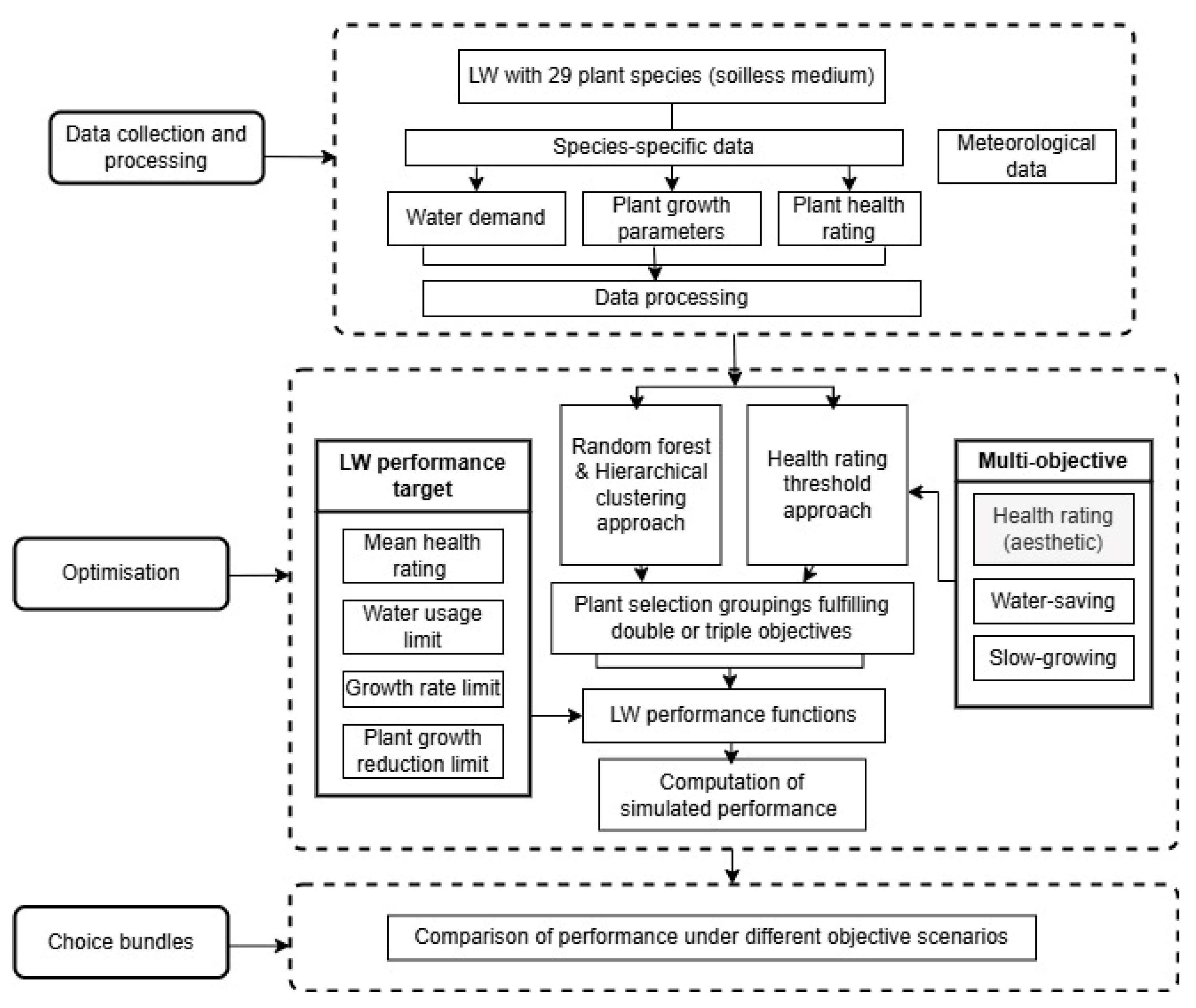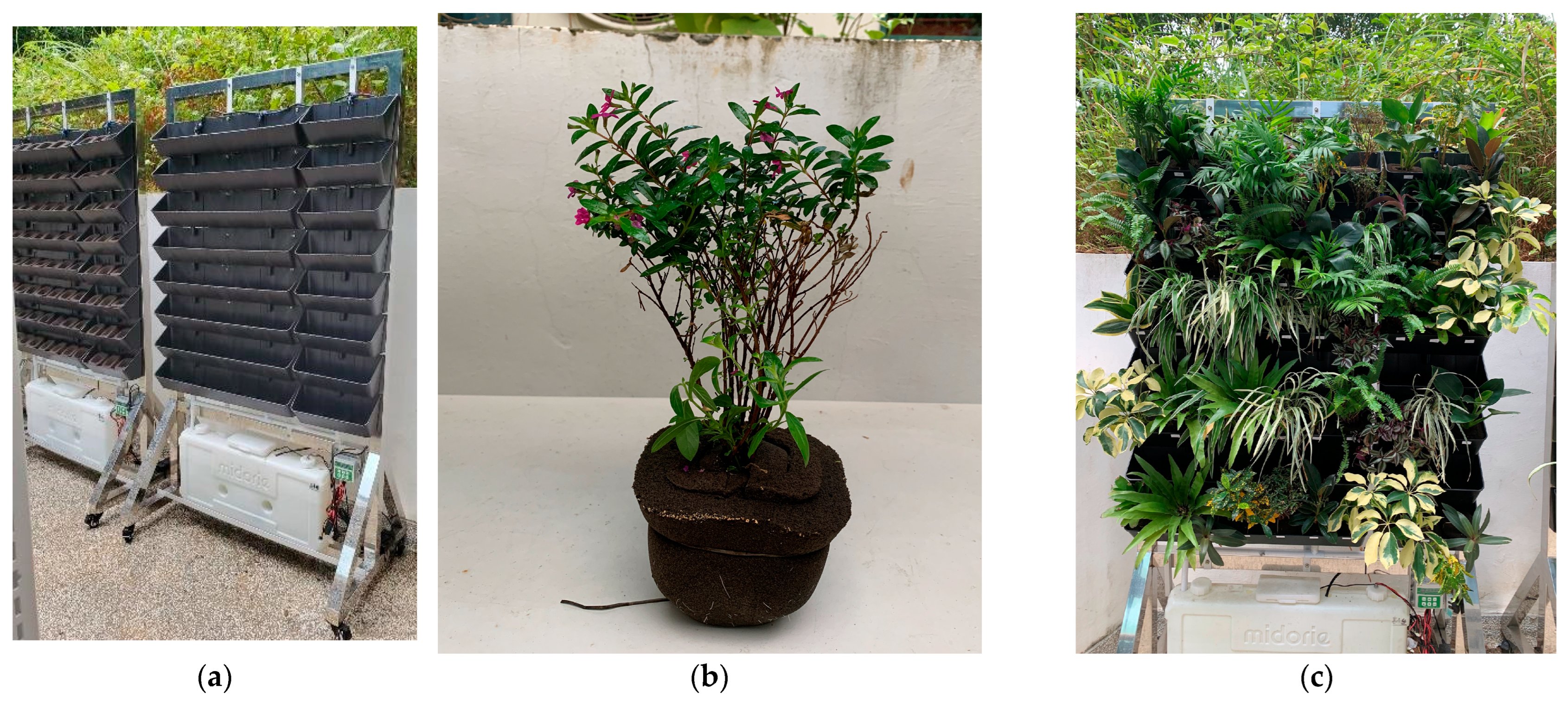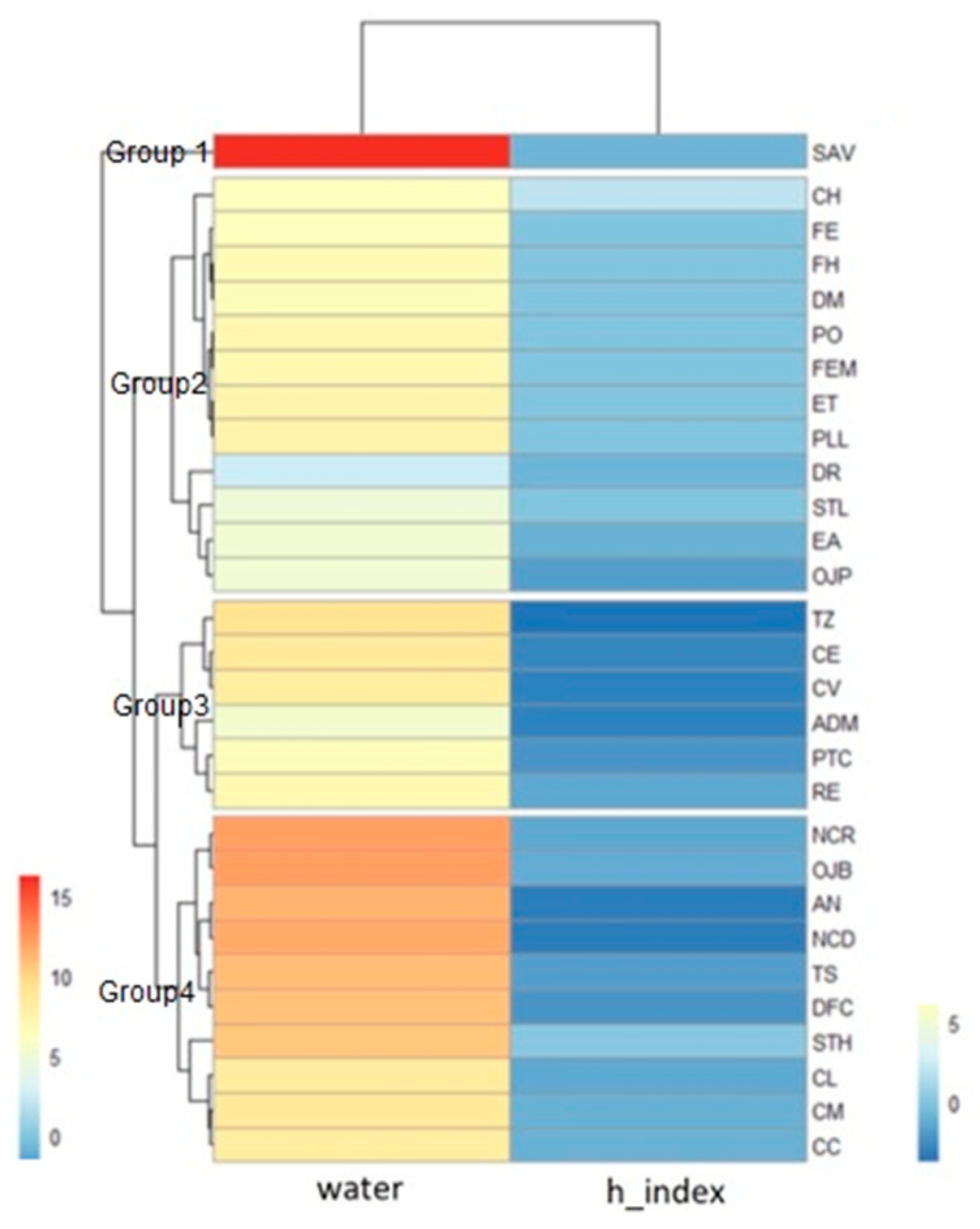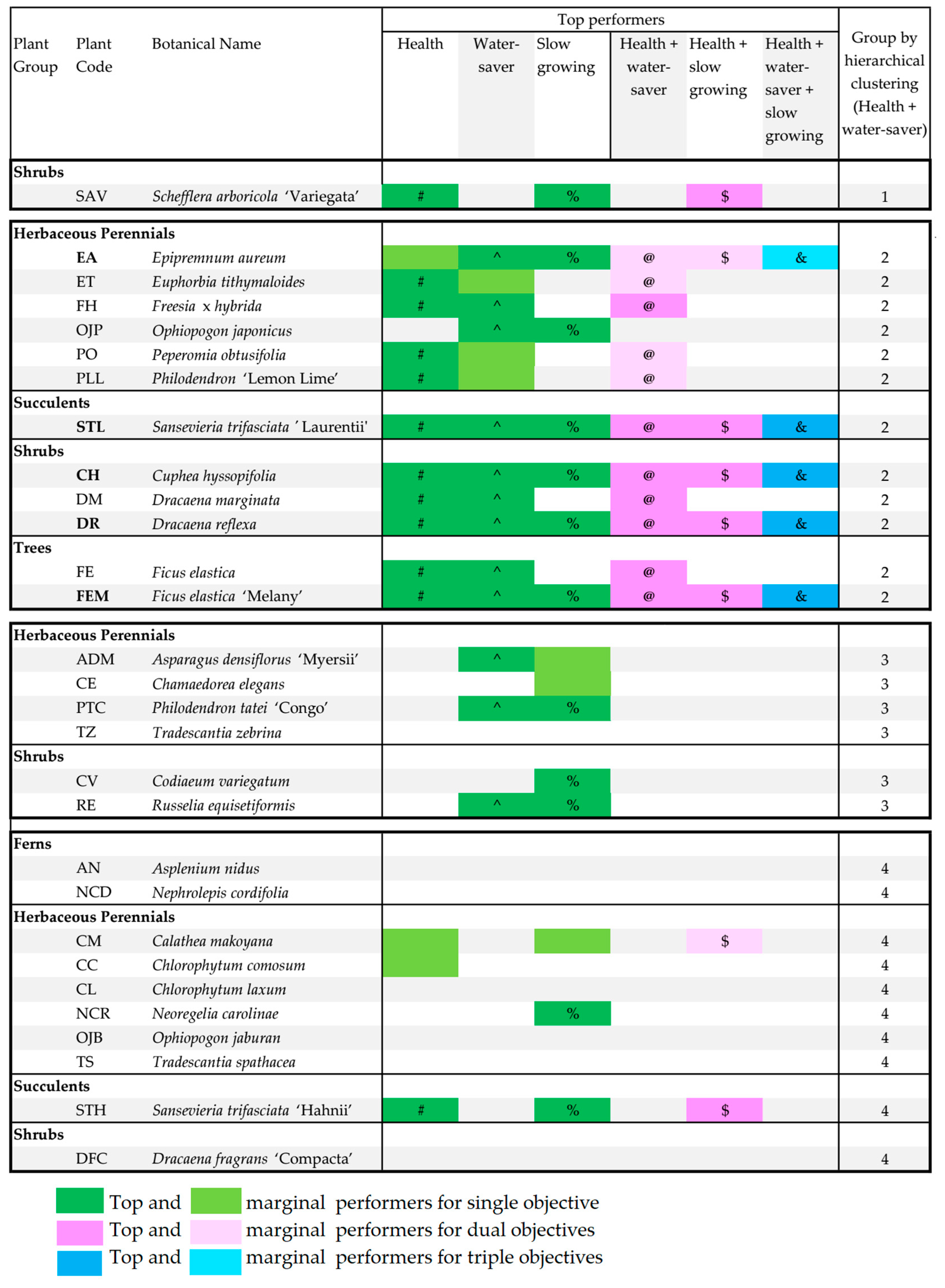Data-Driven Approach for Optimising Plant Species Selection and Planting Design on Outdoor Modular Green Wall with Aesthetic, Maintenance, and Water-Saving Goals
Abstract
:1. Introduction
- Understand plant performance, plant growth, and water demand of commonly used LW plant species under intermittent water supply;
- Explore useful groups of plant species for fulfilling single or multiple LW project objective(s);
- Compare species recommendations based on the health rating threshold approach and hierarchical clustering approach;
- Demonstrate how a data-driven approach can optimise plant species selection and planting design.
2. Materials and Methods
2.1. Research Framework
2.2. Study Site
2.3. Experimental Setup
2.3.1. Living Wall (LW) Panels
2.3.2. Plant Species
2.3.3. Preparation of Plants and Setup
2.4. Measurements and Data Collection
2.4.1. Plant Height, LAI, and Health Rating
- 5 = Excellent. Less than 5% yellowing/wilting of foliage; excellent foliage and root development;
- 4 = Good. A total of 5–10% yellowing/wilting of foliage; good foliage and root development;
- 3 = Fair. A total of 11–20% yellowing/wilting of foliage; fair foliage and root development;
- 2 = Poor. A total of 21–30% yellowing/wilting of foliage; poor foliage and root development;
- 1 = Very poor. Over 30% yellowing/wilting of foliage; very poor foliage and root development.
- 0 = Dead plant.
2.4.2. Water Absorption Measurement
2.4.3. Local Weather
2.5. Data Analysis
2.5.1. Multiple Objectives for Plant Selection on LW Projects
- Aesthetic Objectives: The study focuses on achieving healthy plant growth with adequate leaf area coverage and foliage density, which are essential prerequisites for all living wall projects. Although this study does not account for aesthetic requirements such as naturalistic, tidy, wild, colourful patterns and contrasting foliage textures, it collects data on plant health ratings to track development trends;
- Minimal Maintenance Objective: This objective considers factors like pruning, plant replacement, pest and disease control, nutrient balance, water management, and waste generation. Slow-growing and stable plant traits are preferred for modular living walls to minimise maintenance. Root development was not included in this study due to the short monitoring period. The study tracked plant height differences to measure plant growth;
- Water-Saving Objective: The study focuses on selecting plant species that match minimal water requirements and optimising irrigation setups for precise water management. Data on water absorption amounts is collected under this objective;
- Balancing Multiple Objectives: While choosing plant species to fulfil a single objective is straightforward, living wall projects with multiple objectives may require optimisation when plant species exhibit conflicting traits. Trade-offs among objectives necessitate making concessions to achieve improvement in one area while compromising on another.
2.5.2. Principle of Random Forest and Hierarchical Clustering Algorithm
2.5.3. LW Project Scenarios to Estimate LW Performance
3. Results
3.1. Local Weather Condition
3.2. Plant Health Rating
3.3. Plant Height
3.4. Leaf Area Index
3.5. Water Absorption
3.6. Random Forest Model for Determining Significant Parameters
3.7. Hierarchical Clustering
3.8. Plant Selection Scenarios Under Different LW Objectives
3.9. Data-Driven Optimisation with Projected LW Performance Under Different Scenarios
4. Discussion
4.1. Recommendations on LW Design
4.2. Data-Driven Design and Monitoring Process for LW
4.3. Plant Form Determining Morphophysiological Traits of Plant
4.4. Suggested Data-Driven Analysis for Optimising Plant Selection
- Optimal growing media (optimal combination of indicators like porosity, water holding capacity, air-filled porosity, cation exchange capacity, and particle size distribution);
- Drought resistance (maximum days without irrigation until signs of drought appear)
- Pollutant removal capability (VOC, fine dust deposition);
- Plant cooling effect in relation to water stress and optimal irrigation;
- Carbon sequestration;
- Contribution to biodiversity (larval and nectar plant, flowering and fruiting timing and duration, plant architecture as shelter, rainwater and dew harvesting for wildlife, wildlife species survey utilising and breeding on specific plant).
4.5. Limitations of the Study
5. Conclusions
Author Contributions
Funding
Institutional Review Board Statement
Informed Consent Statement
Data Availability Statement
Acknowledgments
Conflicts of Interest
References
- Wang, C.; Er, S.-S.; Abdul-Rahman, H. Indoor Vertical Greenery System in Urban Tropics. Indoor Built Environ. 2016, 25, 340–356. [Google Scholar] [CrossRef]
- Li, Z. Application of Plants in Chinese Garden Landscape. Can. Soc. Sci. 2014, 10, 143. [Google Scholar]
- Fonseca, F.; Paschoalino, M.; Silva, L. Health and Well-Being Benefits of Outdoor and Indoor Vertical Greening Systems: A Review. Sustainability 2023, 15, 4107. [Google Scholar] [CrossRef]
- Bodo, T. Rapid Urbanisation: Theories, Causes, Consequences and Coping Strategies. Geogr. Res. 2019, 2, 32–35. [Google Scholar] [CrossRef]
- Zhang, X.Q. The Trends, Promises and Challenges of Urbanisation in the World. Habitat Int. 2016, 54, 241–252. [Google Scholar] [CrossRef]
- Sultana, S.; Satyanarayana, A.N. Impact of Urbanisation on Urban Heat Island Intensity during Summer and Winter over Indian Metropolitan Cities. Environ. Monit. Assess. 2019, 191, 789. [Google Scholar] [CrossRef]
- Köhler, M. Green Facades—A View Back and Some Visions. Urban Ecosyst. 2008, 11, 423–436. [Google Scholar] [CrossRef]
- Blanco, I.; Schettini, E.; Mugnozza, G.S.; Vox, G. Thermal behaviour of green façades in summer. J. Agric. Eng. 2018, 49, 183–190. [Google Scholar] [CrossRef]
- Cameron, R.W.F.; Taylor, J.E.; Emmett, M.R. What’s ‘Cool’ in the World of Green Façades? How Plant Choice Influences the Cooling Properties of Green Walls. Build. Environ. 2014, 73, 198–207. [Google Scholar] [CrossRef]
- Carlucci, S.; Charalambous, M.; Tzortzi, J.N. Monitoring and performance evaluation of a green wall in a semi-arid Mediterranean climate. J. Build. Eng. 2023, 77, 107421. [Google Scholar] [CrossRef]
- Cosola, V.O.-D.; Olivieri, F.; Ruiz-García, L. A systematic review of the impact of green walls on urban comfort: Temperature reduction and noise attenuation. Renew. Sustain. Energy Rev. 2022, 162, 112463. [Google Scholar] [CrossRef]
- Perini, K.; Bazzocchi, F.; Croci, L.; Magliocco, A.; Cattaneo, E. The Use of Vertical Greening Systems to Reduce the Energy Demand for Air Conditioning. Field Monit. Mediterr. Clim. Energy Build. 2017, 143, 35–42. [Google Scholar] [CrossRef]
- Cheng, C.Y.; Cheung, K.K.S.; Chu, L.M. Thermal Performance of a Vegetated Cladding System on Facade Walls. Build. Environ. 2010, 45, 1779–1787. [Google Scholar] [CrossRef]
- Dahanayake, K.C.; Chow, C.L. Comparing reduction of building cooling load through green roofs and green walls by EnergyPlus simulations. Build. Simul. 2017, 11, 421–434. [Google Scholar] [CrossRef]
- Alexandri, E.; Jones, P. Temperature Decreases in an Urban Canyon Due to Green Walls and Green Roofs in Diverse Climates. Build. Environ. 2008, 43, 480–493. [Google Scholar] [CrossRef]
- Wong, N.H.; Kwang Tan, A.Y.; Tan, P.Y.; Chiang, K.; Wong, N.C. Acoustics Evaluation of Vertical Greenery Systems for Building Walls. Build. Environ. 2010, 45, 411–420. [Google Scholar] [CrossRef]
- Perini, K.; Ottelé, M.; Giulini, S.; Magliocco, A.; Roccotiello, E. Quantification of Fine Dust Deposition on Different Plant Species in a Vertical Greening System. Ecol. Eng. 2017, 100, 268–276. [Google Scholar] [CrossRef]
- Weerakkody, U.; Dover, J.W.; Mitchell, P.; Reiling, K. Particulate Matter Pollution Capture by Leaves of Seventeen Living Wall Species with Special Reference to Rail-Traffic at a Metropolitan Station. Urban For. Urban Green. 2017, 27, 173–186. [Google Scholar] [CrossRef]
- Pettit, T.; Irga, P.J.; Torpy, F.R. The In Situ Pilot-Scale Phytoremediation of Airborne VOCs and Particulate Matter with an Active Green Wall. Air Qual. Atmos. Health 2019, 12, 33–44. [Google Scholar] [CrossRef]
- Chiquet, C.; Dover, J.W.; Mitchell, P. Birds and the Urban Environment: The Value of Green Walls. Urban Ecosyst. 2013, 16, 453–462. [Google Scholar] [CrossRef]
- Madre, F.; Clergeau, P.; Machon, N.; Vergnes, A. Building Biodiversity: Vegetated Façades as Habitats for Spider and Beetle Assemblages. Glob. Ecol. Conserv. 2015, 3, 222–233. [Google Scholar] [CrossRef]
- Treder, M.; Joedecke, V.; Schweikert, K.; Rosenkranz, P.; Ruttensperger, U.; Traynor, K. Vertical greening systems serve as effective means to promote pollinators: Experimental comparison of vertical and horizontal plantings. Landsc. Urban Plan. 2024, 234, 104951. [Google Scholar] [CrossRef]
- Salisbury, A.; Blanusa, T.; Bostock, H.; Perry, J.N. Careful plant choice can deliver more biodiverse vertical greening (green façades). Urban For. Urban Green. 2023, 89, 128118. [Google Scholar] [CrossRef]
- Riley, B. The State of the Art of Living Walls: Lessons Learned. Build. Environ. 2017, 114, 219–232. [Google Scholar] [CrossRef]
- Chew, M.Y.L.; Conejos, S. Developing a Green Maintainability Framework for Green Walls in Singapore. Struct. Surv. 2016, 34, 379–406. [Google Scholar] [CrossRef]
- Dvorak, B.; Laminack, K.; Volder, A.; Conlee, D. Plant Survival for Living Walls in a Subtropical Climate. In Proceedings of the CitiesAlive 12th Annual Green Roof and Wall Conference, Nashville, TN, USA, 12 November 2014. [Google Scholar]
- Dvorak, B.; Yang, S.; Menotti, T.; Pace, Z.; Mehta, S.; Ali, A.K. Native Plant Establishment on a Custom Modular Living Wall System in a Humid Subtropical Climate. Urban For. Urban Green. 2021, 63, 127234. [Google Scholar] [CrossRef]
- Dvorak, B.D.; Volder, A. Plant Establishment on Unirrigated Green Roof Modules in a Subtropical Climate. AoB PLANTS 2013, 5, pls049. [Google Scholar] [CrossRef]
- Wong, N.H.; Tan, A.Y.K.; Tan, P.Y.; Sia, A.; Wong, N.C. Perception Studies of Vertical Greenery Systems in Singapore. J. Urban Plan. Dev. 2010, 136, 330–338. [Google Scholar] [CrossRef]
- Segovia-Cardozo, D.A.; Rodríguez-Sinobas, L.; Zubelzu, S. Living green walls: Estimation of water requirements and assessment of irrigation management. Urban For. Urban Green 2019, 46, 26458. [Google Scholar] [CrossRef]
- Law, C.; Li, S.; Lam, C. Plant Diversity and Plant Performance of Indoor and Outdoor Vertical Greening Systems in Hong Kong. Environ.-Behav. Proc. J. 2020, 5, 171–177. [Google Scholar] [CrossRef]
- Pérez-Urrestarazu, L.; Urrestarazu, M. Chapter 2.2—Vertical Greening Systems: Irrigation and Maintenance. In Nature Based Strategies for Urban and Building Sustainability; Pérez, G., Perini, K., Eds.; Butterworth-Heinemann: Oxford, UK, 2018; pp. 55–63. [Google Scholar] [CrossRef]
- Jørgensen, L.; Thorup-Kristensen, K.; Dresbøll, D.B. Against the wall—Root growth and competition in four perennial winter hardy plant species grown in living walls. Urban For. Urban Green. 2018, 29, 293–302. [Google Scholar] [CrossRef]
- Farrokhirad, E.; Rigillo, M.; Köhler, M.; Perini, K. Optimising vertical greening systems for sustainability: An integrated design approach. Int. J. Sustain. Energy 2024, 43, 2411831. [Google Scholar] [CrossRef]
- Lands Department. Hong Kong Special Administrative Region Government Lands Department—Hong Kong Geographic Data. Available online: https://www.landsd.gov.hk/en/resources/mapping-information/hk-geographic-data.html (accessed on 14 June 2023).
- Yu, M.; Song, S.; Jiang, C.; Ding, K.; Tan, L.; Ma, J.; Li, Y. Multi-objective optimization of plant community characteristics in urban green spaces. Urban For. Urban Green. 2024, 8, 128397. [Google Scholar] [CrossRef]
- Pichler, M.; Florian, H. Machine Learning and Deep Learning—A Review for Ecologists. Methods Ecol. Evol. 2023, 14, 994–1016. [Google Scholar] [CrossRef]
- Tyagi, A.K. Data Science and Data Analytics: Opportunities and Challenges, 1st ed.; CRC Press: Boca Raton, FL, USA, 2021. [Google Scholar]
- Hong Kong Observatory Monthly Meteorological Normals for Hong Kong (1991–2020). Available online: https://www.hko.gov.hk/en/cis/normal/1991_2020/normals.htm (accessed on 14 June 2023).
- Easlon, H.M.; Bloom, A.J. Easy Leaf Area: Automated Digital Image Analysis for Rapid and Accurate Measurement of Leaf Area. Appl. Plant Sci. 2014, 2, 1400033. [Google Scholar] [CrossRef]
- Rowe, D.B.; Monterusso, M.A.; Rugh, C.L. Assessment of Heat-Expanded Slate and Fertility Requirements in Green Roof Substrates. HortTechnology 2006, 16, 471–477. [Google Scholar] [CrossRef]
- Bénard, C.; Veiga, S.; Scornet, E. Mean Decrease Accuracy for Random Forests: Inconsistency, and a Practical Solution via the Sobol-MDA. Biometrika 2022, 109, 881–900. [Google Scholar] [CrossRef]
- Speiser, J.L.; Michael; Miller, E.; Tooze, J.; Ip, E. A comparison of random forest variable selection methods for classification prediction modeling. Expert Syst. Appl. 2019, 134, 93–101. [Google Scholar] [CrossRef]
- Liaw, A.; Wiener, M. Classification and Regression by RandomForest. Forest 2002, 2, 18–22. [Google Scholar]
- TpointTech. Random Forest Algorithm. Available online: https://www.tpointtech.com/machine-learning-random-forest-algorithm (accessed on 26 March 2025).
- Edureka. A Comprehensive Guide to Random Forest in R. Available online: https://www.edureka.co/blog/random-forest-classifier/ (accessed on 15 February 2024).
- Greenwell, B.M.; Boehmke, B.C. Variable Importance Plots—An Introduction to the vip Package. R J. 2020, 12, 343–366. [Google Scholar] [CrossRef]
- Random Forest in R: A Step-by-Step Guide. Available online: https://www.listendata.com/2014/11/random-forest-with-r.html (accessed on 13 February 2024).
- Random Forest Approach in R Programming. Available online: https://www.geeksforgeeks.org/random-forest-approach-in-r-programming/ (accessed on 5 June 2020).
- Hierarchical Clustering in R. Available online: https://www.datacamp.com/tutorial/hierarchical-clustering-R?utm_source=google&utm_medium=paid_search&utm_campaignid=19589720821&utm_%E2%80%A6 (accessed on 10 July 2024).
- Bowers, A.J.; Zhao, Y.; Ho, E. Towards Hierarchical Cluster Analysis Heatmaps as Visual Data Analysis of Entire Student Cohort Longitudinal Trajectories and Outcomes from Grade 9 through College. High Sch. J. 2022, 106, 5–36. [Google Scholar] [CrossRef]
- Draw Heatmap with Clusters Using Pheatmap in R. Available online: https://www.geeksforgeeks.org/draw-heatmap-with-clusters-using-pheatmap-in-r/ (accessed on 5 June 2023).
- Davenport, T.H. Analytics at Work: Smarter Decisions, Better Results; Harvard Business Review Press: Boston, MA, USA, 2013. [Google Scholar]
- Lausen, E.D.; Emilsson, T.; Jensen, M.B. Water use and drought responses of eight native herbaceous perennials for living wall systems. Urban For. Urban Green. 2020, 54, 126772. [Google Scholar] [CrossRef]






| Plant Code 1 | Botanical Name | Common Name | Plant Form 2 | Plant Origin | Family |
|---|---|---|---|---|---|
| ADM | Asparagus densiflorus ‘Myersii’ | Foxtail Fern | H | Exotic | Liliaceae |
| AN | Asplenium nidus | Bird-nest Fern | F | Native | Aspleniaceae |
| CM | Calathea makoyana | Peacock Plant | H | Exotic | Marantaceae |
| CE | Chamaedorea elegans | Parlour Palm | H | Exotic | Arecaceae |
| CC | Chlorophytum comosum | Bracket Plant | H | Exotic | Liliaceae |
| CL | Chlorophytum laxum | Small-flowered Bracket Plant | H | Native | Liliaceae |
| CV | Codiaeum variegatum | Garden Croton | Sh | Exotic | Euphorbiaceae |
| CH | Cuphea hyssopifolia | False Heather | Sh | Exotic | Lythraceae |
| DFC | Dracaena fragrans ‘Compacta’ | Fragrant Dragon Tree | Sh | Exotic | Agavaceae |
| DM | Dracaena marginata | Madagascar Dragon Tree | Sh | Exotic | Agavaceae |
| DR | Dracaena reflexa | Song of Jamaica | Sh | Exotic | Agavaceae |
| EA | Epipremnum aureum | Ivy-arum | H | Exotic | Araceae |
| ET | Euphorbia tithymaloides | Zigzag Plant | H | Exotic | Euphorbiace |
| FE | Ficus elastica | India-rubber Tree | T | Exotic | Moraceae |
| FEM | Ficus elastica ‘Melany’ | Melany Rubber Plant | T | Exotic | Moraceae |
| FH | Freesia x hybrida | Freesias | H | Exotic | Iridaceae |
| NCR | Neoregelia carolinae | Blushing Bromeliad | H | Exotic | Bromeliaceae |
| NCD | Nephrolepis cordifolia | Fishbone Fern | F | Exotic | Nephrolepidaceae |
| OJB | Ophiopogon jaburan | Jaburan Lily-turf | H | Exotic | Liliaceae |
| OJP | Ophiopogon japonicus | Blue Grass | H | Native | Liliaceae |
| PO | Peperomia obtusifolia | Oval-leaved Peperomia | H | Exotic | Piperaceae |
| PLL | Philodendron ‘Lemon Lime’ | Philodendron Lemon Lime | H | Exotic | Araceae |
| PTC | Philodendron tatei ‘Congo’ | Congo Philodendron | H | Exotic | Araceae |
| RE | Russelia equisetiformis | Coral Plant | Sh | Exotic | Scrophulariaceae |
| STH | Sansevieria trifasciata ‘Hahnii’ | Bird’s Nest Snake Plant | Su | Exotic | Agavaceae |
| STL | Sansevieria trifasciata ‘Laurentii’ | Mother-in-law’s Tongue | Su | Exotic | Agavaceae |
| SAV | Schefflera arboricola ‘Variegata’ | Variegated-leaved Miniature Umbrella Plant | Sh | Exotic | Araliaceae |
| TS | Tradescantia spathacea | Oyster Plant | H | Exotic | Commelinaceae |
| TZ | Tradescantia zebrina | Wandering Jew Zebrina | H | Exotic | Commelinaceae |
| Date | Ambient Temperature (°C) | Relative Humidity (%) | Solar Radiation Index (lx) | Wind Speed (m/s) |
|---|---|---|---|---|
| 24 January 2022 | 25.3 | 70.2 | 355.83 | 0.1 |
| 27 January 2022 | 23.4 | 76.2 | 601.43 | 0.3 |
| 29 January 2022 | 20.0 | 76.3 | 1540.20 | 0.4 |
| 1 February 2022 | 19.8 | 75.7 | 1333.65 | 0.2 |
| 3 February 2022 | 16.5 | 78.4 | 2478.17 | 0.6 |
| 6 February 2022 | 16.5 | 70.8 | 5244.50 | 0.3 |
| 8 February 2022 | 16.0 | 85.4 | 3264.33 | 0.3 |
| 11 February 2022 | 16.6 | 79.5 | 1669.00 | 0.2 |
| 14 February 2022 | 16.8 | 79.6 | 1836.17 | 0.3 |
| Water Absorption on Number of Days (mL) | Total Water Absorption (mL) | Daily Mean (mL) | ||||||||||
|---|---|---|---|---|---|---|---|---|---|---|---|---|
| Code | Botanical Name | Day 0 | Day3 | Day5 | Day 8 | Day 10 | Day 13 | Day 15 | Day 18 | Day 21 | ||
| Ferns | ||||||||||||
| AN | Asplenium nidus | 240.0 | 240.0 | 11.43 | ||||||||
| NCD | Nephrolepis cordifolia | 75.0 | 172.5 | 247.5 | 11.79 | |||||||
| Herbaceous Perennials | ||||||||||||
| ADM | Asparagus densiflorus ‘Myersii’ | 112.5 | 112.5 | 5.36 | ||||||||
| CM | Calathea makoyana | 180.0 | 180.0 | 8.57 | ||||||||
| CE | Chamaedorea elegans | 180.0 | 180.0 | 8.57 | ||||||||
| CC | Chlorophytum comosum | 172.5 | 172.5 | 8.21 | ||||||||
| CL | Chlorophytum laxum | 175.0 | 175.0 | 8.33 | ||||||||
| EA | Epipremnum aureum | 110.0 | 110.0 | 5.24 | ||||||||
| ET | Euphorbia tithymaloides | 153.3 | 153.3 | 7.30 | ||||||||
| FH | Freesia x hybrida | 142.5 | 142.5 | 6.79 | ||||||||
| NCR | Neoregelia carolinae | 112.5 | 145.0 | 257.5 | 12.26 | |||||||
| OJB | Ophiopogon jaburan | 147.5 | 107.5 | 255.0 | 12.14 | |||||||
| OJP | Ophiopogon japonicus | 110.0 | 110.0 | 5.24 | ||||||||
| PO | Peperomia obtusifolia | 150.0 | 150.0 | 7.14 | ||||||||
| PLL | Philodendron ‘Lemon Lime’ | 157.5 | 157.5 | 7.50 | ||||||||
| PTC | Philodendron tatei ‘Congo’ | 140.0 | 140.0 | 6.67 | ||||||||
| TS | Tradescantia spathacea | 127.5 | 105.0 | 232.5 | 11.07 | |||||||
| TZ | Tradescantia zebrina | 75.0 | 116.3 | 191.3 | 9.11 | |||||||
| Succulents | ||||||||||||
| STH | Sansevieria trifasciata ‘Hahnii’ | 55.0 | 45.0 | 122.5 | 222.5 | 10.60 | ||||||
| STL | Sansevieria trifasciata ‘Laurentii’ | 100.0 | 100.0 | 4.76 | ||||||||
| Shrubs | ||||||||||||
| CV | Codiaeum variegatum | 67.5 | 105.0 | 172.5 | 8.21 | |||||||
| CH | Cuphea hyssopifolia | 130.0 | 130.0 | 6.19 | ||||||||
| DFC | Dracaena fragrans ‘Compacta’ | 62.5 | 162.5 | 225.0 | 10.71 | |||||||
| DM | Dracaena marginata | 140.0 | 140.0 | 6.67 | ||||||||
| DR | Dracaena reflexa | 52.5 | 52.5 | 2.50 | ||||||||
| RE | Russelia equisetiformis | 145.0 | 145.0 | 6.90 | ||||||||
| SAV | Schefflera arboricola ‘Variegata’ | 142.5 | 200.0 | 342.5 | 16.31 | |||||||
| Trees | ||||||||||||
| FE | Ficus elastica | 135.0 | 135.0 | 6.43 | ||||||||
| FEM | Ficus elastica ‘Melany’ | 147.5 | 147.5 | 7.02 | ||||||||
| No. of spp | No. of Plant per spp | Water Consumption (mL) | Average Health Rating | Plant Growth | Reduction in Plant Height | |||||
|---|---|---|---|---|---|---|---|---|---|---|
| Plant Selection Scenarios (Plant Codes) | Total | Per Plant | No. of Plants | Average % of Height | No. of spp | No. of Plants | Average % of Height | |||
| Health + water-saver (Top performers: FH, STL, CH, DM, DR, FE, FEM) | 7 | 142 | 121,107 | 121.10 | 4.751 | 858 | 2.33% | 1 | 142 | −0.99% |
| Health + water-saver (Top + marginal performers: FH, STL, CH, DM, DR, FE, FEM + EA, ET, PO, PLL) | 11 | 91 | 128,940 | 128.94 | 4.749 | 818 | 2.25% | 2 | 182 | −2.67% |
| Health + slow-growing (Top performers: SAV, STL, CH, DR, FEM, STH) | 6 | 167 | 165,866 | 165.87 | 4.509 | 666 | 0.78% | 2 | 334 | −0.97% |
| Health + slow-growing (Top + marginal performers: SAV, STL, CH, DR, FEM, STH + EA, CM) | 8 | 125 | 160,625 | 160.63 | 4.375 | 625 | 0.63% | 3 | 375 | −1.44% |
| Health + water-saver + slow-growing (Top performers: STL, CH, DR, FEM) | 4 | 250 | 107,500 | 107.5 | 4.562 | 750 | 0.38% | 1 | 250 | −0.800% |
| Health + water-saver + slow-growing (Top + marginal performers: STL, CH, DR, FEM + EA) | 5 | 200 | 108,000 | 108.00 | 4.45 | 800 | 0.35% | 1 | 200 | −1.00% |
| Hierarchical clustering (Health + water-saver: EA, ET, FH, OJP, PO, PLL, STL, CH, DM, DR, FE, FEM) | 12 | 83 | 126,851 | 126.85 | 4.586 | 834 | 2.02% | 2 | 166 | −2.67% |
Disclaimer/Publisher’s Note: The statements, opinions and data contained in all publications are solely those of the individual author(s) and contributor(s) and not of MDPI and/or the editor(s). MDPI and/or the editor(s) disclaim responsibility for any injury to people or property resulting from any ideas, methods, instructions or products referred to in the content. |
© 2025 by the authors. Licensee MDPI, Basel, Switzerland. This article is an open access article distributed under the terms and conditions of the Creative Commons Attribution (CC BY) license (https://creativecommons.org/licenses/by/4.0/).
Share and Cite
Law, C.M.Y.; Law, H.Y.; Li, C.H.; Leung, C.W.; Pan, M.; Chen, S.; Ho, K.C.K.; Sham, Y.T. Data-Driven Approach for Optimising Plant Species Selection and Planting Design on Outdoor Modular Green Wall with Aesthetic, Maintenance, and Water-Saving Goals. Sustainability 2025, 17, 3528. https://doi.org/10.3390/su17083528
Law CMY, Law HY, Li CH, Leung CW, Pan M, Chen S, Ho KCK, Sham YT. Data-Driven Approach for Optimising Plant Species Selection and Planting Design on Outdoor Modular Green Wall with Aesthetic, Maintenance, and Water-Saving Goals. Sustainability. 2025; 17(8):3528. https://doi.org/10.3390/su17083528
Chicago/Turabian StyleLaw, Caroline M. Y., Hoi Yi Law, Chi Ho Li, Chung Wai Leung, Min Pan, Si Chen, Kenrick C. K. Ho, and Yik Tung Sham. 2025. "Data-Driven Approach for Optimising Plant Species Selection and Planting Design on Outdoor Modular Green Wall with Aesthetic, Maintenance, and Water-Saving Goals" Sustainability 17, no. 8: 3528. https://doi.org/10.3390/su17083528
APA StyleLaw, C. M. Y., Law, H. Y., Li, C. H., Leung, C. W., Pan, M., Chen, S., Ho, K. C. K., & Sham, Y. T. (2025). Data-Driven Approach for Optimising Plant Species Selection and Planting Design on Outdoor Modular Green Wall with Aesthetic, Maintenance, and Water-Saving Goals. Sustainability, 17(8), 3528. https://doi.org/10.3390/su17083528








